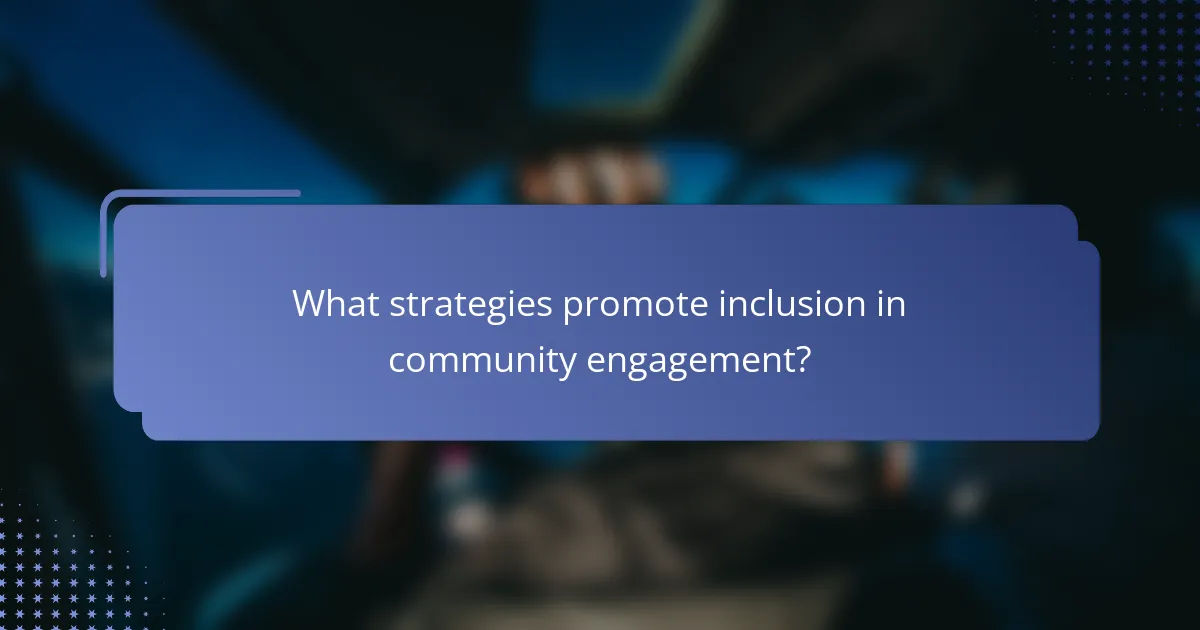Community engagement is essential for fostering participation, inclusion, and development among residents. By creating an inclusive environment that values diverse voices, communities can enhance their engagement initiatives through technology, events, and feedback channels. Effective strategies ensure that all members can participate meaningfully, paving the way for sustainable development and empowered decision-making.

How can communities enhance participation in engagement initiatives?
Communities can enhance participation in engagement initiatives by fostering an inclusive environment that encourages diverse voices. This can be achieved through strategic use of technology, organizing events, and creating feedback channels that empower residents to contribute actively.
Utilizing social media platforms
Social media platforms serve as powerful tools for enhancing participation by providing accessible channels for communication and interaction. Communities can create dedicated pages or groups to share information, solicit opinions, and promote events, ensuring that residents stay informed and engaged.
To maximize effectiveness, communities should consider using popular platforms like Facebook, Instagram, and Twitter, tailoring content to suit each platform’s audience. Regular updates and interactive posts can significantly boost engagement levels.
Organizing community events
Community events are vital for fostering participation as they provide opportunities for face-to-face interaction and relationship building. Organizing events such as town hall meetings, workshops, or festivals can draw in diverse groups and encourage dialogue among residents.
When planning events, consider varying the formats and times to accommodate different schedules and preferences. Offering activities for all ages can also enhance participation and create a sense of belonging within the community.
Implementing feedback mechanisms
Feedback mechanisms are essential for understanding community needs and preferences, thus enhancing participation. Surveys, suggestion boxes, and online polls allow residents to voice their opinions and contribute ideas for initiatives.
Communities should ensure that feedback is acted upon and communicated back to residents, demonstrating that their input is valued. This can foster a culture of trust and encourage ongoing engagement.
Collaborating with local organizations
Collaboration with local organizations can significantly enhance participation by leveraging existing networks and resources. Partnering with schools, non-profits, and businesses can help reach a broader audience and provide additional support for initiatives.
Communities should identify key local organizations that align with their goals and explore ways to work together on projects or events. This can include co-hosting workshops or sharing resources to maximize impact.
Offering incentives for involvement
Offering incentives can effectively boost participation in community initiatives. Incentives can range from recognition programs to tangible rewards such as gift cards or discounts at local businesses, encouraging residents to engage more actively.
Communities should consider what types of incentives resonate most with their residents and ensure that they are easily accessible. Clear communication about available incentives can motivate individuals to participate and contribute to community goals.

What strategies promote inclusion in community engagement?
Strategies that promote inclusion in community engagement focus on ensuring that all community members can participate meaningfully. This involves creating accessible programs, encouraging diverse representation, providing language support services, and fostering safe spaces for dialogue.
Creating accessible programs
Accessible programs are designed to accommodate the needs of all community members, including those with disabilities. This can involve physical accessibility at venues, such as ramps and elevators, as well as offering materials in various formats, like braille or large print.
Consider using technology to enhance accessibility, such as live captioning during events or virtual participation options. Regularly seek feedback from participants to identify barriers and improve future programs.
Encouraging diverse representation
Diverse representation in community engagement ensures that various perspectives and backgrounds are included in decision-making processes. Actively recruit participants from underrepresented groups by collaborating with local organizations that serve these communities.
Utilize outreach strategies that resonate with different demographics, such as social media campaigns or community events tailored to specific cultural groups. This approach not only enriches discussions but also builds trust and rapport within the community.
Providing language support services
Language support services are essential for engaging non-native speakers in community activities. Offering translation and interpretation services can help bridge communication gaps and ensure that everyone can contribute effectively.
Consider providing materials in multiple languages and hiring bilingual staff or volunteers to facilitate discussions. This practice not only enhances participation but also demonstrates respect for cultural diversity.
Fostering safe spaces for dialogue
Creating safe spaces for dialogue allows community members to express their thoughts and feelings without fear of judgment or backlash. Establish ground rules for discussions that promote respect and confidentiality, ensuring everyone feels valued.
Encourage open dialogue by facilitating workshops or forums where participants can share their experiences and perspectives. Regularly assess the environment to ensure it remains welcoming and inclusive for all voices.

What are effective development practices for community engagement?
Effective development practices for community engagement focus on fostering participation, inclusion, and empowerment among community members. These practices create a foundation for sustainable development by ensuring that all voices are heard and valued in the decision-making process.
Training community leaders
Training community leaders is essential for effective community engagement. Leaders equipped with skills in communication, conflict resolution, and project management can better mobilize residents and facilitate discussions. Programs should focus on practical workshops that allow leaders to practice these skills in real-life scenarios.
Consider incorporating local experts to provide culturally relevant training. This can enhance relatability and effectiveness, ensuring that leaders understand the unique challenges and opportunities within their community.
Establishing mentorship programs
Mentorship programs connect experienced individuals with emerging leaders in the community. These relationships foster knowledge transfer and skill development, which are crucial for sustainable engagement. Pairing mentors and mentees based on shared interests or goals can enhance the effectiveness of these programs.
To implement a successful mentorship program, set clear objectives and provide resources for both mentors and mentees. Regular check-ins can help maintain motivation and address any challenges that arise during the mentorship process.
Conducting needs assessments
Conducting needs assessments helps identify the specific needs and priorities of a community. This process involves gathering data through surveys, interviews, and focus groups to understand the challenges residents face. Engaging community members in this assessment ensures that the findings are relevant and actionable.
When conducting a needs assessment, aim for a diverse representation of community voices to avoid bias. Analyze the data to prioritize needs and develop targeted strategies that address the most pressing issues effectively.
Utilizing participatory budgeting
Participatory budgeting empowers community members to have a direct say in how public funds are allocated. This process involves residents proposing and voting on projects that will benefit their community, fostering a sense of ownership and accountability. It can lead to more equitable distribution of resources and increased public trust in local governance.
To implement participatory budgeting, ensure that the process is transparent and accessible. Provide clear guidelines and support to help residents understand how to propose projects and participate in the voting process. Regular feedback on the outcomes can further enhance community engagement and trust.

What metrics measure the success of community engagement?
Success in community engagement can be measured through various metrics that reflect participation, feedback, and overall satisfaction. Key indicators include participation rates, the quality of feedback received, and results from community satisfaction surveys.
Participation rates
Participation rates indicate the level of community involvement in engagement activities. This can be quantified by tracking attendance at events, the number of volunteers, or the percentage of community members who contribute to discussions or initiatives.
To effectively measure participation, consider setting benchmarks based on previous events or similar communities. For example, a participation rate of 30-50% is often seen as strong in local initiatives.
Feedback quality
The quality of feedback is crucial for understanding community needs and preferences. High-quality feedback is specific, actionable, and reflects a diverse range of community voices. Collecting feedback through open-ended questions can yield richer insights than simple yes/no responses.
When evaluating feedback, look for common themes and suggestions that can inform future initiatives. Aim for a balance between quantitative ratings and qualitative comments to get a comprehensive view of community sentiment.
Community satisfaction surveys
Community satisfaction surveys are structured tools used to gauge how residents feel about engagement efforts and community services. These surveys typically include questions about perceived effectiveness, areas for improvement, and overall satisfaction levels.
To ensure meaningful results, design surveys that are concise and easy to complete, ideally taking no longer than 5-10 minutes. Aim for a response rate of at least 20-30% to ensure the data is representative of the community’s views.

How do local governments support community engagement?
Local governments support community engagement through various initiatives that promote participation, inclusion, and development. These efforts often include funding, resources, and programs designed to empower residents and foster collaboration within the community.
Funding for community projects
Local governments typically allocate funds to support community projects that enhance public spaces, improve services, or address specific community needs. This funding can come from various sources, including local taxes, state grants, and federal programs.
Communities can apply for funding through formal proposals that outline project goals, budgets, and expected outcomes. It’s essential to demonstrate community support and involvement in the project to increase the chances of receiving funding.
- Identify potential funding sources, such as local government grants or partnerships with nonprofits.
- Engage community members in the planning process to ensure the project meets their needs.
- Prepare a clear and concise proposal that highlights the project’s benefits and community impact.



